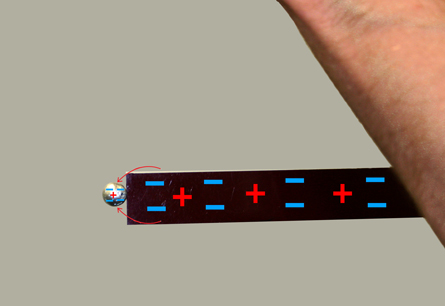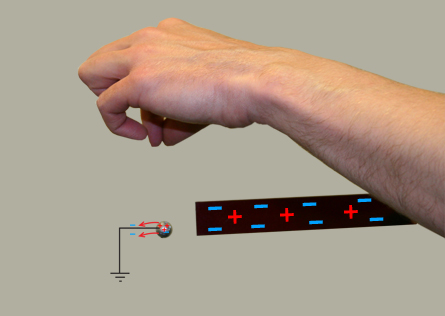Module 3
1. Module 3
1.7. Page 5
Module 3—Electrical Phenomenon
Three Methods of Transferring Charge
Method 1: Charging by Friction

When you rubbed the balloon with the wool sweater earlier in this activity, you were charging both of these objects by friction. When two objects are charged this way, one always develops a positive charge while the other develops a negative charge. Why is this always the case? The answer has to do with the law of conservation of charge.
 Read
Read
You can learn about the law of conservation of charge and charging by friction by reading “Methods of Charging Objects” beginning on page 517 and ending on page 519 of your textbook.
 Self-Check
Self-Check
You can check your understanding by answering these questions:
SC 14. The balloon is made from a material that holds its electrons more tightly than wool.
- If a balloon is rubbed with wool, state the resulting charge on the balloon and on the wool.
- Explain why the process of rubbing the balloon with the wool does not generate additional electrons.
- Explain why it is essential for the balloon to be an insulator in order for the excess charges on its surface to remain in place.
 Self-Check Answers
Self-Check Answers
SC 14.
- The process of rubbing removes electrons from the wool and transfers them to the balloon. This leaves the wool positively charged and the balloon negatively charged.
- Rubbing the balloon with the wool did not generate additional electrons. The electrons were simply rearranged, since they were transferred from the wool to the balloon.
- Charging by friction involves transferring electrons from one object to another by rubbing. If the balloon were a conductor instead of an insulator, then the excess electrons would simply migrate across its surface and possibly return to the wool.
Three Methods of Transferring Charge
Method 2: Charging by Conduction

 Watch and Listen
Watch and Listen
You can see how an electroscope can be charged by conduction by selecting the “Charge by Conduction” button in the linked animation.
 Read
Read
The law of conservation of charge is also used to explain what occurs when an object is charged by conduction. To find out more about this, read “Charging Objects by Conduction” on page 519 of your textbook.
 Self-Check
Self-Check
You can check your understanding by answering these questions:
SC 16. Use the idea of conduction to explain what happens when you get a shock from a doorknob after acquiring excess electrons from scuffing your feet across a floor.
SC 17. Explain what occurs when a positively charged object is touched to the knob of a neutral electroscope.
 Self-Check Answers
Self-Check Answers
SC 16. This is an example of conduction because electrons are transferred from your negatively charged fingertips to the neutrally charged doorknob as soon as you establish contact.
SC 17. When a positively charged object is touched to the knob of a neutral electroscope, some of the electrons within the electroscope are attracted to the positive object. After the electrons transfer from the electroscope to the positively charged object, the electroscope is left positively charged. Since each of the leaves is now positively charged, the leaves repel one another and diverge.
Three Methods of Transferring Charge
Method 3: Charging by Induction

 Watch and Listen
Watch and Listen
You can see how an electroscope can be charged by induction by selecting the “Charge by Induction” button in the linked animation.
 Read
Read
The most complex method of giving an object a charge is charging by induction. You can learn more about this procedure by reading “Charging Objects by Induction” on pages 520 and 521 of your textbook.
 Self-Check
Self-Check
You can check your understanding by answering these questions:
SC 18. Define induction.
SC 19. The link Induction with a Negative Source shows a negative source charging an electroscope by induction. Write a concise description or illustrate with labels to explain what is occurring during each step of this process.
SC 20. Take one of your balloons and rub it vigorously with the wool sweater once again. Place the balloon high against a smooth, dry wall. See if the balloon will stick. If it does not, try recharging the balloon with the wool.
Concisely explain why the balloon can remain stuck to the wall and why this effect is able to last for many minutes.
SC 21. Sketch a series of diagrams to show how a positive source could charge an electroscope by induction. Write a concise description or illustrate with labels to explain what is occurring during each step of this process.